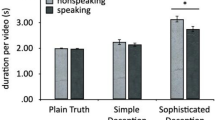
Overview
- One of the first books to study the link between human behavior in group settings with facial expressions and speech analysis
- One of the first books to illustrate how advanced machine learning and deep learning techniques can be used to predict deceptive behavior
- Combines social science models and computational models for better understanding of deception, like/dislike, dominance/deference, and other interpersonal behaviors
- Analyzes the impact of culture on interpersonal deception
- Includes one of the most in-depth, multimodal analyses of relational communication in groups
Part of the book series: Terrorism, Security, and Computation (TESECO)
Access this book
Tax calculation will be finalised at checkout
Other ways to access
About this book
This book analyzes the multimodal verbal and nonverbal behavior of humans in both an artificial game, based on the well-known Mafia and Resistance games, as well as selected other settings. This book develops statistical results linking different types of facial expressions (e.g. smile, pursed lips, raised eyebrows), vocal features (e.g., pitch, loudness) and linguistic features (e.g., dominant language, turn length) with both unary behaviors (e.g. is person X lying?) to binary behaviors (Is person X dominant compared to person Y? Does X trust Y? Does X like Y?). In addition, this book describes machine learning and computer vision-based algorithms that can be used to predict deception, as well as the visual focus of attention of people during discussions that can be linked to many binary behaviors. It is written by a multidisciplinary team of both social scientists and computer scientists.
Meetings are at the very heart of human activity. Whether you are involved in a business meeting or in a diplomatic negotiation, such an event has multiple actors, some cooperative and some adversarial. Some actors may be deceptive, others may have complex relationships with others in the group. This book consists of a set of 11 chapters that describe the factors that link human behavior in group settings and attitudes to facial and voice characteristics.
Researchers working in social sciences (communication, psychology, cognitive science) with an interest in studying the link between human interpersonal behavior and facial/speech/linguistic characteristics will be interested in this book. Computer scientists, who are interested in developing machine learning and deep learning based models of human behavior in group settings will also be interested in purchasing this book.
Similar content being viewed by others
Keywords
- Human behavior
- deception
- dominance
- deference
- like/dislike
- trust
- computer vision
- machine learning
- Facial Analysis
- statistical modeling
- neural networks
- speech and linguistic analysis
- nonverbal communication
- kinesics
- vocalics
- computational linguistics
- interpersonal deception
- relational communication
- security
Table of contents (11 chapters)
-
Front Matter
-
Theory Underlying Investigating Deception in Groups
-
Front Matter
-
-
The SCAN Project
-
Front Matter
-
-
SCAN Project Foundations: Preceding Empirical Investigations of Deception
-
Front Matter
-
Editors and Affiliations
About the editors
Judee K. Burgoon is Director of Research for the Center for the Management of Information at the University of Arizona, where she holds titles as professor of communication, family studies and human development. She has authored or edited 17 books and monographs (Detecting Trust and Deception in Group Interaction, Social Signal Processing, Discovering Hidden Temporal Patterns in Behavior and Interaction, Nonverbal Communication, Interpersonal Adaptation, Small Group Communication, Mexican Americans and the Mass Media) and over 300 articles, chapters and reviews. Her current research on deception, dyadic interaction, and technologies for automated analysis of nonverbal and verbal communication has been funded by the National Science Foundation; Department of Defense Air Force, Army, Navy and ODNI; Department of Homeland Security; IARPA; and Gannett Foundation, among others. She is the recipient of the highest honors given by the International Communication Association and National Communication Association and has held several offices in NCA including Chair of the Nonverbal Communication Division and Chair of the Research Board. She also served as Site Director of the Center for Identification Research, an NSF multi-university research organization.
Norah E. Dunbar is a Professor of Communication at the Universityof California Santa Barbara. She teaches courses in nonverbal and interpersonal communication, communication theory, and deception detection. She is also an Affiliate Faculty in the Center for Information, Technology & Society; the Center for Digital Games Research; the Center for Responsible Machine Learning, and the Quantitative Methods in the Social Sciences program. She has received over $13 Million in research funding from agencies such as the Intelligence Advanced Research Projects Activity, the National Science Foundation, the Department of Defense, and the Center for Identification Technology Research. She has published over 65 peer-reviewed journal articles and book chapters and has presented over 100 papers at National and International conferences. Her research has appeared in top journals in her discipline including Communication Research, Communication Monographs, and Journal of Computer-Mediated Communication as well as interdisciplinary journals such as Journal of Management Information Systems and Computers in Human Behavior. She has served on the editorial board of over a dozen disciplinary journals and as the Chair of the Nonverbal Division of the National Communication Association in 2014-2016. She is the current Chair of the Communication Department at UCSB.Bibliographic Information
Book Title: Detecting Trust and Deception in Group Interaction
Editors: V. S. Subrahmanian, Judee K. Burgoon, Norah E. Dunbar
Series Title: Terrorism, Security, and Computation
DOI: https://doi.org/10.1007/978-3-030-54383-9
Publisher: Springer Cham
eBook Packages: Computer Science, Computer Science (R0)
Copyright Information: The Editor(s) (if applicable) and The Author(s), under exclusive license to Springer Nature Switzerland AG 2021
Hardcover ISBN: 978-3-030-54382-2Published: 08 February 2021
Softcover ISBN: 978-3-030-54385-3Published: 08 February 2022
eBook ISBN: 978-3-030-54383-9Published: 07 February 2021
Series ISSN: 2197-8778
Series E-ISSN: 2197-8786
Edition Number: 1
Number of Pages: X, 222
Number of Illustrations: 5 b/w illustrations, 42 illustrations in colour
Topics: Machine Learning, Computer Science, general, Media and Communication, Image Processing and Computer Vision



